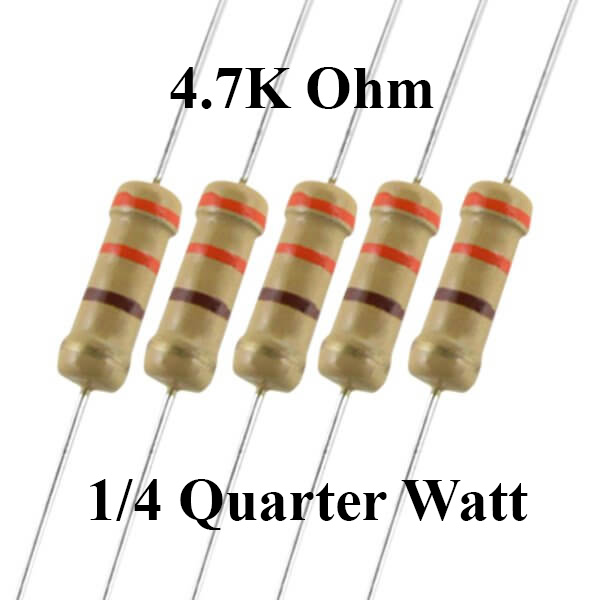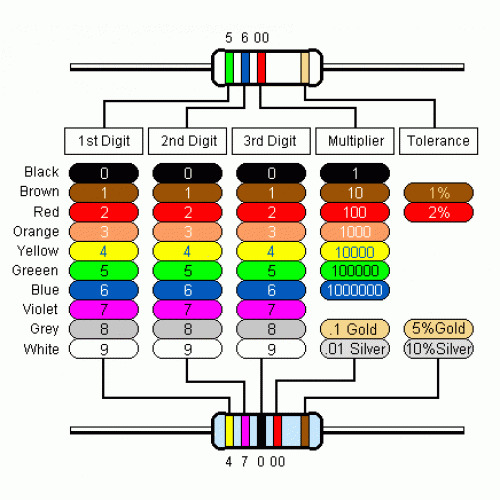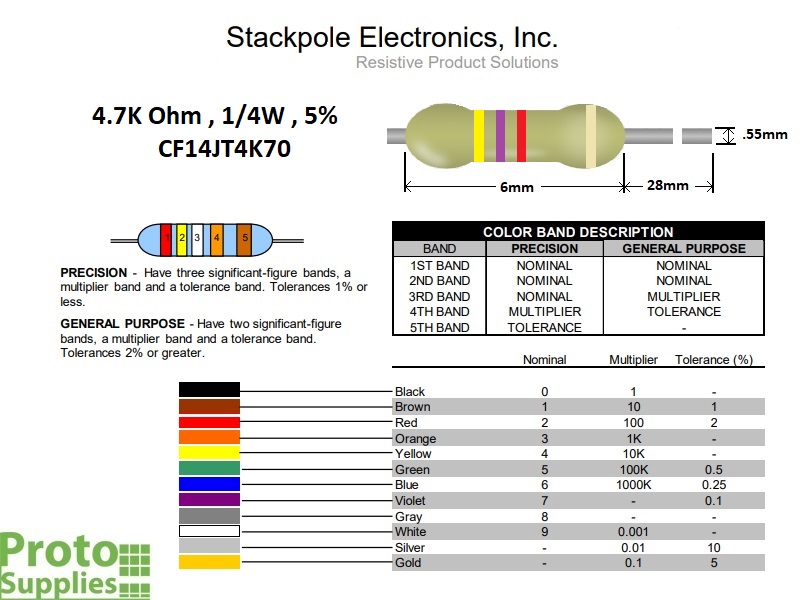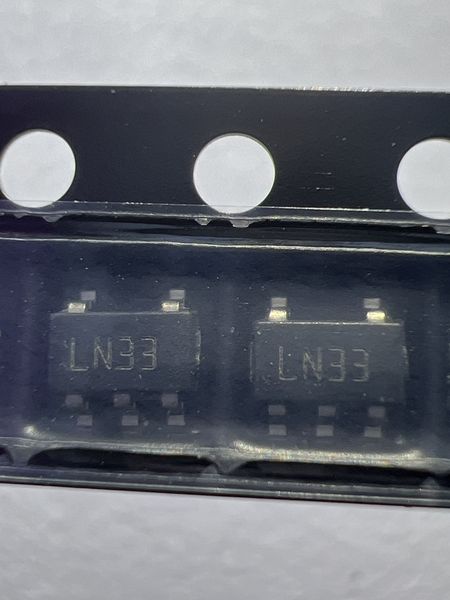A "4k7 resistor" refers to a resistor with a resistance value of 4.7 kilohms, often represented in electronics shorthand as "4k7" using the metric system prefix "k" for kilo, which denotes a factor of 1,000. Here are some key points about the 4.7 kilohm resistor:

-
Resistance Value: The resistance value of a 4.7 kilohm resistor is 4700 ohms, or 4.7 kilohms. It restricts the flow of electric current in a circuit, following Ohm's Law (V = I * R), where "V" is voltage, "I" is current, and "R" is resistance.
-
Tolerance: Resistors have a specified tolerance that indicates the percentage of variation from the nominal resistance value. Common tolerance values for resistors include 5%, 1%, and others. A 4.7k resistor with a 5% tolerance could have an actual resistance value within 5% above or below 4.7 kilohms.
-
Power Rating: The power rating of the resistor specifies the maximum amount of power it can dissipate without getting damaged. The power rating is typically specified in watts. For a 4.7k resistor, the power rating depends on the resistor's construction and material.
-
Color Coding: In through-hole resistors, the color bands are used to indicate the resistance value and tolerance. The color code for a 4.7k ohm resistor could typically be yellow, violet, red, and gold; where yellow represents 4, violet represents 7, red represents the number of zeros (2 zeros in this case, making it 4.7k), and gold represents the tolerance.
-
Applications: Resistors are fundamental components in electronic circuits and are used for various purposes, such as current limiting, voltage division, pull-up or pull-down resistors, biasing components in amplifiers, filters, and many other applications.
A 4.7 kilohm resistor, or 4k7 resistor, is a standard resistor value commonly used in electronic circuits for different purposes based on the required resistance level. When selecting a resistor for a specific application, factors such as tolerance, power rating, and application requirements should be taken into consideration to ensure proper functioning and stability in the circuit.

4k7/4.7k Resistor Color Code
The color code for a 4.7 kilohm (4k7) resistor typically follows the standard color code system used to indicate the resistance value and tolerance of resistors. In this system, each color corresponds to a numeric value. Here is how the color bands would be arranged for a 4.7k ohm resistor:
- First Band (Digit 1 - Thousands): Yellow
- Second Band (Digit 2 - Hundreds): Violet
- Third Band (Digit 3 - Tens): Red
- Fourth Band (Multiplier - Ohms): No band or color (indicating "x1")
- Fifth Band (Tolerance): Gold
In summary, for a 4.7 kilohm resistor (4k7):
- Yellow: 4 (representing thousands)
- Violet: 7 (representing hundreds)
- Red: 0 (representing tens)
- No band or color for the multiplier
- Gold: Tolerance of +/- 5%
Therefore, a 4.7k ohm resistor would have the color bands Yellow, Violet, Red, and Gold, with no band for the multiplier, as described above. This color code system helps in quickly identifying the resistance value and tolerance of a resistor at a glance.

Resistance Tolerance of 4.7k Resistor
The resistance tolerance of a resistor refers to the maximum allowable deviation from the specified resistance value. For a 4.7k ohm resistor, the typical tolerance values available are:
-
5% Tolerance: A 4.7k resistor with a 5% tolerance means that the actual resistance of the resistor can vary by up to +/- 5% from the marked nominal value. In the case of a 4.7k resistor with a 5% tolerance, the actual resistance could range from 4.465k ohms to 4.935k ohms.
-
1% Tolerance: In higher precision applications, resistors with a 1% tolerance are commonly used. A 4.7k resistor with a 1% tolerance would have a tighter tolerance band, allowing the resistance to vary by only +/- 1% from the marked value. This would result in an actual resistance range of 4.653k ohms to 4.747k ohms for a 4.7k resistor with a 1% tolerance.
The resistance tolerance is an important consideration in circuit design, especially in applications where precision and accuracy are crucial. For most general-purpose applications, a 5% tolerance resistor is common and cost-effective. However, for more precise or sensitive circuits, a 1% tolerance resistor may be preferred to ensure tighter control over the circuit's performance.
Common uses for 4.7k ohm Resistors
4.7k ohm resistors, like other standard resistor values, have a variety of common uses across different electronic circuits. Here are some common applications where 4.7k ohm resistors are frequently employed:
-
Voltage Divider Circuits: 4.7k resistors are often used in voltage divider circuits to create reference voltages or to scale down voltages for input to different components in a circuit.
-
Pull-up or Pull-down Resistors: They are used as pull-up or pull-down resistors in digital circuits to ensure that the input to a microcontroller or other digital device is in a defined state when no other input is present.
-
Biasing Transistors: In transistor biasing circuits, 4.7k ohm resistors can be used to set the operating point of the transistor by providing the necessary biasing voltage and current.
-
LED Circuits: 4.7k resistors are often used in series with LEDs to limit the current flowing through the LED and protect it from damage due to excessive current.
-
Oscillator Circuits: In oscillator circuits, 4.7k resistors can be used to set the frequency of oscillation by controlling the timing in RC oscillator circuits.
-
Filter Circuits: They can be used as part of passive filter circuits, such as low-pass, high-pass, or band-pass filters, to adjust the cutoff frequencies and shape the frequency response.
-
Voltage Divider for Sensor Reading: Used in conjunction with sensors (e.g., light sensors, temperature sensors) to create voltage dividers that help in analog sensor readings.
-
Noise Suppression: In audio circuits, 4.7k resistors can be used in combination with capacitors for noise suppression and filtering.
-
Current Limiting: They can be used as current-limiting resistors for limiting the current that flows through a circuit or device.
-
Input/Output Protection: Used in various protection circuits to limit current or voltage levels and protect sensitive components from damage.
These are just a few examples of the many applications where 4.7k ohm resistors are commonly used. Their versatility and availability make them essential components in various electronic circuits across industries ranging from consumer electronics to industrial applications.


